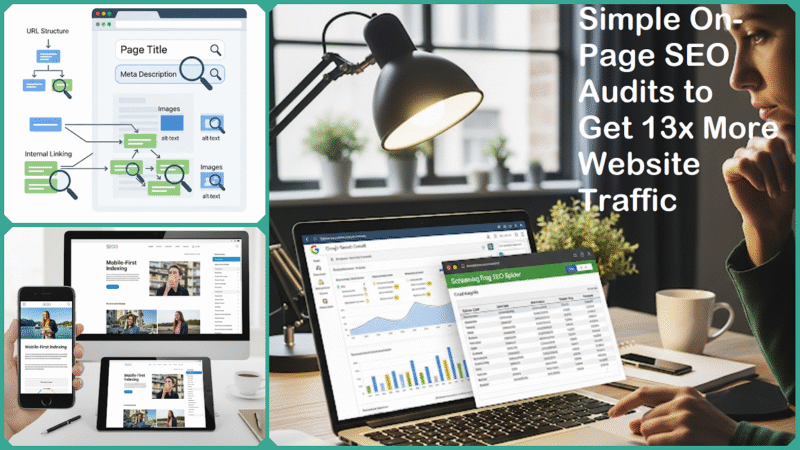Top Technical SEO Optimization Fundamentals You Must Know
Estimated reading time: 25 minutes
Having a website is only the very first step in establishing your presence in today’s ever-evolving and competitive digital landscape. To truly succeed and make your site stand out, it is crucial to ensure that your website ranks highly on popular search engines such as Google. Achieving this requires a deep understanding and mastery of the fundamentals of technical SEO optimization. By focusing on these essential techniques, you can significantly improve your site’s visibility and effectively drive a steady stream of organic traffic to your pages.
Technical SEO primarily focuses on enhancing the underlying infrastructure and backend components of your website. This optimization ensures that search engines are able to efficiently crawl, accurately index, and properly render all of your website’s content. By addressing these technical aspects, you improve your site’s visibility and performance in search engine results.

Whether you are a beginner or an intermediate marketer, a small business owner who manages your website, a web developer, or a content creator, having a solid understanding of these technical basics empowers you to take control and optimize your site effectively without relying on costly experts.
This knowledge enables you to improve user experience significantly, making your site more accessible and enjoyable for visitors, while also boosting your search engine visibility, which can lead to increased traffic and better overall performance.
Why Technical SEO Matters
Technical SEO is critically important because it serves as the essential foundation and backbone of your entire SEO strategy, making sure that your website is fully accessible, easily understandable, and highly efficient for search engines to crawl, index, and ultimately rank.
Regardless of how excellent your content is or how well you have planned your keyword strategies, if search engines encounter difficulties accessing or correctly interpreting your web pages due to various technical problems, your search rankings and overall organic visibility will be negatively impacted and suffer significantly over time.
Key reasons why technical SEO is essential and plays a crucial role include:
- Improved Crawling and Indexing: Technical SEO involves optimizing your website’s overall structure, URL hierarchy, and sitemap in a detailed and strategic manner. This optimization plays a crucial role in helping search engines efficiently crawl through and index every important page on your site. Without proper technical SEO, many valuable pieces of content risk remaining hidden or undiscovered by search engines, which can significantly limit your site’s visibility and organic traffic potential.
- Enhanced User Experience: Google is placing growing emphasis on various user experience signals, including fast loading times (site speed), mobile usability, and secure browsing through HTTPS protocols. Technical SEO plays a crucial role in making sure your website is highly responsive, loads quickly across all devices, and maintains strong security standards. These improvements not only create a more enjoyable and seamless experience for users but also significantly boost your search engine rankings, ultimately benefiting both visitors and your online visibility.
- Boosts Ranking Potential: Key factors, including page speed, mobile-friendliness, and the accurate implementation of metadata, serve as direct ranking elements that originate from comprehensive technical optimization. A website that is technically well-structured and optimized is significantly more likely to achieve a higher ranking in search engine results compared to a site that offers similar content but suffers from technical deficiencies and shortcomings.
- Reduces Errors and Penalties: Technical SEO plays a crucial role in identifying and resolving issues such as broken links, duplicate content, and server errors. These problems can negatively impact your website’s search engine rankings or even prevent important pages from being properly indexed by search engines. By addressing these technical issues promptly, you ensure that your site runs smoothly, which helps maintain and improve your visibility in search results.
- Supports Advanced SEO Tactics: Key elements like structured data, including schema markup, play a crucial role in enhancing how search engines comprehend and interpret your website’s content. This improved understanding allows search engines to generate rich snippets, which are visually enhanced search results that stand out on the results page. These rich snippets significantly boost click-through rates by making your listings more attractive and informative, ultimately leading to greater search visibility and higher traffic to your site.
In Summary
Technical SEO establishes the essential strong, fast, and secure foundation that supports and enhances all other SEO strategies—such as content creation, keyword optimization, and link building—enabling them to be fully effective and deliver maximum results.
Neglecting technical SEO can seriously jeopardize your search engine visibility, significantly increasing the risk that your website will fall behind competitors. This oversight can cause a substantial loss of valuable traffic, as potential visitors are more likely to choose websites that have invested in better-optimized, technically sound structures.
Ensuring that your technical SEO is thoroughly up to date is crucial for maintaining a strong competitive edge in the digital marketplace and for attracting a steady, consistent flow of organic traffic to your website. Keeping these technical aspects current helps improve your site’s overall performance, user experience, and search engine rankings, which are all essential for long-term online success.
Key Concepts and Fundamentals of Technical SEO Optimization
Let’s take a detailed look at the core principles and fundamental building blocks that make a website technically sound and effective for search engines. This will serve as a foundational overview of the essential concepts and ideas you need to fully understand and grasp before you start diving into more specific and advanced optimization tips and strategies.
Technical SEO is the essential foundation that enables search engines to effectively crawl, index, and interpret your website’s content, all while delivering a smooth user experience. Let’s explore the key fundamentals you need to understand, explaining their importance and sharing best practices for successful implementation.
Crawlability and Indexability
Crawlability is a search engine bot’s ability to access, explore, and navigate through your website pages effectively. It determines how well the bot can reach and scan all the content on your site. Indexability, on the other hand, refers to whether those crawled pages are included, processed, and stored in the search engine’s index, allowing them to be retrieved and displayed in search results when relevant queries are made.
- Why it matters: If your web pages cannot be properly crawled or indexed by search engines, they will simply never appear in search engine results pages, regardless of how excellent your content is or how well you have optimized your keywords. This means all the effort you put into creating valuable content and selecting the right keywords will be wasted if search engines are unable to access and process your pages effectively.
Best practices:
- Robots.txt file: This file tells search engine bots which parts of your site to crawl and which to ignore. For example, you might block admin pages or duplicate content folders to avoid wasting crawl budget. However, ensure important pages aren’t accidentally blocked here.
- Meta robots tags: Add meta tags (e.g.,
<meta name="robots" content="noindex">) on specific pages when you want to prevent them from being indexed. This is useful for pages like thank-you pages or internal search results that add no SEO value. - XML sitemaps: An XML sitemap is like a roadmap listing important URLs on your site. Submitting and regularly updating your sitemap in tools such as Google Search Console helps search engines discover your pages quickly.
- Avoid broken links & server errors: Pages that return errors (like 404 Not Found or 500 Server Errors) prevent bots from crawling your site properly, wasting crawl budget and harming rankings. Regularly audit and fix these issues.
Site Architecture and URL Structure
Site architecture refers to the way your content is systematically organized and interconnected through internal links within your website. It establishes a clear framework that helps users and search engines navigate your site more efficiently.
On the other hand, URL structure pertains to the specific format and hierarchical arrangement of your web addresses, defining how each page’s URL is constructed and positioned within the overall site hierarchy. This structure not only impacts usability but also plays a significant role in search engine optimization and user experience.
- Why it matters: A clear and logical site layout is essential because it helps search engines better understand the importance and relationship of your content. When your website is organized intuitively, search engines can more easily interpret the hierarchy and relevance of different pages. Additionally, a well-structured layout greatly enhances user navigation, making it simpler for visitors to find the information they need. This improved user experience reduces bounce rates significantly and encourages visitors to engage more deeply with your content, ultimately leading to higher retention and better overall site performance.
Best practices:
- Keep site structure flat: Important pages should be reachable within a few clicks from the homepage. Deeply nested pages can get less crawl priority.
- Logical and descriptive URLs: Use URLs that convey content meaning and hierarchy, e.g.,
domain.com/blog/technical-seo-guideinstead ofdomain.com/post?id=12345. Include relevant keywords where appropriate, but avoid keyword stuffing. - Internal linking: Link related pages internally with descriptive anchor text to help both users and crawlers navigate.
- Avoid orphan pages: Ensure every page has at least one internal link pointing to it, so it’s discoverable by bots.
Website Performance & Speed
How quickly your web pages load and how promptly they respond to every user action and interaction is crucial for creating a seamless and enjoyable browsing experience. The speed at which content appears and reacts plays a significant role in keeping visitors engaged and satisfied.
- Why it matters: Site speed is not only a direct ranking factor used by the Google algorithm but also plays a crucial role in shaping the overall user experience on your website. Pages that load slowly tend to frustrate visitors, leading to higher bounce rates as users leave before the content fully appears. This increased bounce rate negatively impacts your chances of ranking well in search results, making fast-loading pages essential for both SEO success and keeping users engaged.
Best practices:
- Optimize images: Compress and resize images without losing quality; use modern formats like WebP.
- Minimize code: Remove unnecessary CSS, JavaScript, and HTML, and combine files where possible to reduce HTTP requests.
- Use caching: Browser and server caching reduce load times for repeat visitors.
- Deploy Content Delivery Networks (CDNs): CDNs deliver site content from servers closer to visitors geographically, speeding up load time globally.
- Monitor Core Web Vitals: Focus on Largest Contentful Paint (LCP), First Input Delay (FID), and Cumulative Layout Shift (CLS) to meet Google’s user experience benchmarks.
Mobile-Friendliness
Ensuring that your website functions smoothly and efficiently across a wide range of mobile devices with different screen sizes, resolutions, and operating environments. This includes optimizing performance, usability, and responsiveness to provide an excellent user experience regardless of the device being used.
- Why it matters: Google’s mobile-first indexing approach means that it primarily relies on the mobile version of your website to evaluate and determine your search engine rankings. If your mobile site offers a poor user experience, it can significantly damage both your SEO performance and your overall conversion rates, leading to fewer visitors and lower engagement.
Best practices:
- Responsive design: Use fluid layouts and flexible images that adapt to different screen sizes.
- Test mobile usability: Run tests with the Mobile-Friendly Test tool and real devices.
- Avoid intrusive interstitials: Pop-ups or ads that cover content can frustrate users and are penalized by Google.
- Optimize for mobile speed: Use AMP (Accelerated Mobile Pages) or similar techniques for faster mobile load.
HTTPS & Site Security
Serving your website over a secure HTTPS connection instead of the traditional HTTP protocol ensures that the data transferred between your server and your users is encrypted and protected from interception or tampering.
This enhanced security helps build trust with your visitors by safeguarding sensitive information such as login credentials, personal details, and payment data. Additionally, using HTTPS can improve your website’s search engine ranking and overall credibility in the eyes of both users and browsers.
- Why it matters: Google considers HTTPS as an important ranking factor in its search algorithm, which means that websites using HTTPS are more likely to appear higher in search results. Additionally, users have come to expect secure connections when browsing the internet, particularly on websites that collect sensitive information such as personal details, payment information, or login credentials. Ensuring your site uses HTTPS not only helps improve your search engine ranking but also builds trust with your visitors by protecting their data and providing a safer browsing experience overall.
Best practices:
- Install SSL certificates: Implement SSL to encrypt data between the server and user, enhancing security and trust.
- Redirect HTTP to HTTPS: Ensure all traffic automatically directs to the secure version to avoid duplicate content issues.
Structured Data and Schema Markup
Structured data is a standardized and organized format specifically designed for providing detailed information about your webpage and accurately classifying its various types of content. This format helps search engines and other systems better understand the context and meaning of the information presented on your page.
- Why it matters: Implementing this helps search engines gain a much clearer and deeper understanding of your site’s overall content context. This improved comprehension can lead to enhanced search results such as rich snippets, knowledge panels, or even carousels, all of which contribute to making your listings more visually appealing and informative. As a result, these improvements can significantly boost your click-through rate (CTR), driving more traffic to your site and improving its performance in search rankings.
Best practices:
- Use schema.org vocabulary: Implement appropriate schema types for articles, products, reviews, events, FAQs, etc.
- Test your markup: Use Google’s Rich Results Test or Schema Validator tools to confirm implementation.
Canonicalization & Duplicate Content Handling
Addressing situations in which identical or very similar content is accessible through multiple different URLs on a website or across the internet. This often occurs when the same page can be reached by several distinct web addresses, potentially leading to confusion for both users and search engines.
Understanding how to manage these scenarios is crucial to ensure that the correct version of the content is prioritized and that duplicate content issues are minimized. Proper handling of such cases helps improve website organization, user experience, and search engine optimization by consolidating the authority and ranking signals to a single preferred URL.
- Why it matters: Duplicate content can create significant confusion for search engines as they struggle to determine which version to prioritize. This confusion often leads to diluted ranking signals across multiple pages rather than concentrating authority on a single source. Additionally, duplicate content may result in indexing problems, where some pages are not properly indexed or rewarded in search results, ultimately affecting the overall visibility and performance of your website.
Best practices:
- Use canonical tags (
<link rel="canonical">): Indicate the preferred URL version for a piece of content. - Avoid boilerplate or duplicated content: Regularly audit for duplicates and consolidate or eliminate where possible.
Handling Redirects and 404 Errors
Effectively managing URL changes and handling broken pages gracefully is essential for maintaining a positive user experience and preserving search engine rankings. When URLs are updated or modified, it is important to implement proper redirects, such as 301 redirects, to ensure visitors and search engines are seamlessly directed to the new locations without encountering errors.
Additionally, setting up custom 404 error pages that are informative and user-friendly helps guide users back to relevant content instead of leaving them frustrated with dead ends. By proactively addressing URL changes and broken pages with thoughtful strategies, websites can enhance navigation, reduce bounce rates, and sustain their overall online presence.
- Why it matters: Redirects play a crucial role in preserving link equity whenever URLs are changed or updated, ensuring that valuable search engine rankings and traffic are not lost. Additionally, having user-friendly 404 error pages significantly helps to minimize bounce rates by guiding visitors away from frustrating dead ends and encouraging them to explore other relevant parts of the website.
Best practices:
- Implement 301 redirects: When URLs change, permanently redirect old URLs to new ones to preserve SEO value.
- Fix broken links: Regularly check for and correct links pointing to non-existent pages.
- Design custom 404 pages: Provide helpful navigation or search functionality on error pages to keep users engaged.
Summary of the Key Concepts and Fundamentals of Technical SEO Optimization
| Fundamental | Purpose | Key Action Items |
|---|---|---|
| Crawlability & Indexability | Ensure pages can be discovered & indexed | Manage robots.txt, meta robots, XML sitemaps, and fix errors |
| Site Architecture & URLs | Logical structure & navigation | Flat hierarchy, descriptive URLs, internal linking |
| Website Performance & Speed | Improve load times & user experience | Optimize images, caching, CDNs, minimize code, and monitor Core Web Vitals |
| Mobile-Friendliness | Responsive design & mobile usability | Responsive layout, mobile testing, and avoiding intrusive pop-ups |
| HTTPS & Security | Secure data & improve trust & rankings | SSL certificates, HTTP to HTTPS redirects |
| Structured Data & Schema | Enhanced understanding & rich results | Implement schema.org markup, test regularly |
| Canonicalization & Duplicates | Avoid content confusion & dilution | Use canonical tags, audit duplicate content |
| Redirects & 404 Handling | Manage URL changes & broken links | 301 redirects, fix broken links, and friendly 404 pages |
Current Trends and Developments in Technical SEO
Technical SEO is evolving at an accelerated pace in 2025, driven by significant innovations and advancements in the way search engines crawl, interpret, and ultimately rank websites. Staying up to date with these changes is essential for maintaining and improving your website’s visibility.
Below, you will find the most important and current trends and developments in technical SEO that you need to be aware of to stay ahead in the competitive digital landscape:
JavaScript SEO
With the widespread use of JavaScript frameworks like React, Angular, and Vue, ensuring that search engines can properly crawl and render JavaScript-heavy websites is essential. This means developers must implement server-side rendering (SSR), dynamic rendering, or hydration techniques so that bots can access the full content without getting blocked or misinterpreting the site structure.
Improving JavaScript SEO significantly helps prevent a variety of indexing issues that commonly arise on modern single-page applications (SPAs) and progressive web apps (PWAs). By optimizing JavaScript SEO, developers can ensure that search engines properly crawl and index dynamic content, which is crucial for maintaining visibility and ranking in search results.
This process addresses challenges unique to SPAs and PWAs, where content is often loaded asynchronously or rendered client-side, potentially causing important pages or elements to be missed by search engine crawlers.
Core Web Vitals Are Now Ranking Priorities
Google’s Core Web Vitals — which include Largest Contentful Paint (LCP), First Input Delay (FID), and Cumulative Layout Shift (CLS) — are essential user experience metrics that have a direct impact on search engine ranking.
These metrics have become crucial benchmarks that every website owner must focus on to enhance their site’s visibility in search results. Optimizing these Core Web Vitals is no longer optional but a necessary step toward achieving better search performance and providing a seamless experience for users.
For instance, the Largest Contentful Paint (LCP) should ideally occur within 2.5 seconds to be considered a good performance indicator, ensuring that the main content loads quickly. Similarly, the Cumulative Layout Shift (CLS) needs to be kept to a minimum to prevent unexpected and disruptive shifts in page elements, which can negatively affect user interaction and satisfaction.
AI and Automation in SEO Audits
Artificial intelligence-powered SEO tools and platforms have revolutionized the way technical audits are conducted by automating complex processes that previously demanded extensive manual analysis and expertise. These advanced tools are capable of efficiently and accurately detecting a wide range of issues such as crawl errors, broken links, duplicate content, schema markup problems, and various performance bottlenecks that can affect website ranking and user experience.
By leveraging automation, SEO teams are empowered to quickly prioritize fixes based on their potential impact, enabling faster problem resolution and maintaining optimal site health on an ongoing basis. This continuous monitoring and improvement significantly enhances the overall effectiveness of SEO strategies and contributes to sustained website success.
Mobile-First Indexing Is Fully Established
Google now primarily relies on the mobile version of websites when it comes to indexing and ranking content. This means that beyond just having a responsive design, websites must ensure they deliver a truly seamless and intuitive usability experience on mobile devices.
Key elements include navigation that is easy to use with thumbs, rapid mobile load times, and interactive components that remain fully accessible and functional on smaller screens. Websites that offer poor mobile experiences face increasing penalties in search rankings, making dedicated and thorough mobile optimization essential in today’s digital landscape.
HTTP/3 and Enhanced Security Protocols
The adoption of HTTP/3, which is the latest and most advanced version of the HTTP protocol, is steadily increasing across the web. This protocol introduces several innovative features — including the ability to multiplex multiple streams efficiently over UDP — that contribute to significantly faster loading times and enhanced security when compared to its predecessor, HTTP/2.
Ensuring that websites are secured with HTTPS continues to be a fundamental baseline requirement for protecting user data and privacy; however, newer protocols like HTTP/3 go beyond this by further improving site speed, responsiveness, and overall reliability, especially when accessed on mobile networks where connection quality can often vary.
Practical Case Study Summary
A small e-commerce website that was struggling with poor organic search visibility as a result of various technical SEO issues experienced a significant and noticeable improvement following the implementation of carefully targeted and strategic fixes:
- Simplified its overly bloated JavaScript framework significantly to enhance overall crawlability and improve rendering performance by various search engine bots. This optimization helps ensure that search bots can more efficiently access, interpret, and index the website content without delays or errors caused by excessive or complicated JavaScript code.
- Submitted a properly configured XML sitemap, carefully ensuring that all the key and most important pages of the website were fully discoverable and easily indexable by search engines. This sitemap was designed to help improve the website’s visibility and ensure comprehensive coverage of all relevant content.
- Optimized website images by carefully compressing them to reduce file size without losing quality, and implemented effective browser caching strategies to significantly enhance overall site speed and improve user experience.
Within just three months, these carefully implemented technical SEO improvements resulted in an impressive 60% increase in organic traffic, clearly demonstrating the crucial and indispensable role that a solid foundation of technical health plays in enhancing overall search performance and visibility.
Supporting 2025 Best Practices from SEO Experts
- Conduct comprehensive and regular technical SEO audits by utilizing advanced AI-powered tools, which enable you to swiftly identify, analyze, and prioritize various site health issues with greater accuracy and efficiency.
- Advance well beyond basic schema markup to implement highly detailed and precise structured data for various elements, including products, frequently asked questions (FAQs), events, and local business schemas, ensuring enhanced accuracy and richer information presentation.
- Optimize for the continuously evolving and increasingly important Core Web Vitals metrics to ensure full alignment with Google’s latest user experience ranking signals and guidelines. This approach helps improve website performance and user satisfaction, which are critical factors in search engine rankings.
- Embrace mobile-first usability audits to deliver a truly seamless and intuitive experience tailored specifically for the predominantly mobile audience that engages with your content daily. By prioritizing mobile usability, you ensure that every interaction is smooth, efficient, and enjoyable across all mobile devices.
- Prepare thoroughly for the ongoing and continuous changes in crawling and indexing related to JavaScript SEO by working closely and collaboratively with development teams to ensure smooth adaptation and implementation of best practices.
By consistently staying up-to-date with the latest technical SEO trends and proactively addressing these changes as they arise, website owners and SEO professionals will be well-equipped to maintain websites that remain competitive and achieve high rankings in search engine results throughout 2025 and in the years that follow.
This ongoing vigilance and continuous adaptation are essential for maintaining and sustaining a strong online visibility presence, which in turn plays a crucial role in driving sustained and continued organic traffic growth over an extended period of time.
FAQs
What is the difference between technical SEO and on-page SEO?
- Technical SEO focuses on optimizing your website’s backend infrastructure and overall site health. It includes improving crawlability, site speed, mobile-friendliness, security (HTTPS), structured data, and fixing errors that affect search engines’ ability to access and index your content properly.
- On-page SEO deals with optimizing individual web pages’ visible elements and HTML source code, such as keywords, title tags, meta descriptions, header tags (H1, H2), and content relevance to help pages rank better for target queries.
How often should I perform a technical SEO audit?
Technical SEO audits should be performed regularly to ensure your website remains healthy and search engine-friendly. Ideally, conduct a full audit at least quarterly, especially after any major updates or redesigns. Additionally, frequent spot checks are helpful when you notice traffic dips or indexing issues.
Can I do technical SEO myself without expert help?
Many technical SEO tasks can be managed without deep coding knowledge, especially with the help of popular tools and plugins. For example, you can create and submit sitemaps, fix broken links, enhance mobile usability, and monitor site speed using free or low-cost tools like Google Search Console and Google PageSpeed Insights. However, complex issues like advanced JavaScript rendering or server configurations might require developer assistance.
How does site speed impact SEO?
Site speed is a proven ranking factor according to Google and significantly affects user experience. Pages that load slowly lead to higher bounce rates as users expect quick and smooth navigation. Google’s Core Web Vitals — including Largest Contentful Paint (LCP), First Input Delay (FID), and Cumulative Layout Shift (CLS) — assess page load speed and responsiveness. Enhancing these metrics can boost your search rankings and increase user engagement.
What tools do experts use to monitor technical SEO?
Experts in the field depend on a comprehensive combination of specialized tools to thoroughly audit, continuously monitor, and effectively optimize every aspect of technical SEO:
- Google Search Console: For monitoring crawl errors, indexing status, sitemap submission, and security issues.
- Screaming Frog SEO Spider: Detailed on-site crawling to find broken links, redirects, duplicate content, and metadata issues.
- Ahrefs & SEMrush Site Audit: Comprehensive SEO auditing platforms that identify technical problems across your site.
- Google PageSpeed Insights & Lighthouse: For analyzing site performance, page speed, and Core Web Vitals.
- Additional tools: GTmetrix, DeepCrawl, Moz Pro, and others, depending on specific needs.
In Conclusion
Embarking on your technical SEO journey marks a crucial and foundational step toward unlocking the full and immense potential of your website’s organic search performance and visibility. To get started effectively and ensure you build a strong SEO foundation:
- Conduct Audits Regularly: Use free tools like Google Search Console and Google PageSpeed Insights to identify technical issues impacting crawlability, site speed, and mobile usability. Regular auditing helps detect problems early and keeps your site healthy.
- Prioritize Key Fixes: Focus on resolving errors that hinder search engines from crawling or indexing your content, improving page load times, and enhancing mobile responsiveness. These factors have a direct impact on rankings and user experience.
- Organize Your Site Structure: Develop a logical, flat site architecture with clean, keyword-relevant URLs and robust internal linking. This makes it easier for search engines to discover and rank your pages while providing visitors with an intuitive navigation experience.
- Leverage Structured Data: Implement schema markup to help search engines better understand your content, enabling rich results like featured snippets and enhanced listings that drive higher click-through rates.
- Stay Current: SEO is ever-evolving. Keep yourself informed about changes in search engine algorithms, emerging technical standards, and new optimization tools to maintain and improve your competitive edge.
For marketers and small business owners alike, dedicating time and effort to thoroughly mastering these essential technical SEO fundamentals significantly amplifies the overall effectiveness and impact of your content creation and marketing strategies. This focused investment not only enhances the quality of your work but also plays a crucial role in turning casual visitors into loyal, long-term customers by improving your online visibility and fostering greater engagement across all platforms.
For web developers and designers, incorporating and applying technical SEO best practices right from the very beginning of the development process ensures that the websites you create are not only optimized effectively for search engines but also maintain excellent usability and high performance throughout. This approach guarantees a seamless balance between search engine visibility and a positive user experience.
Ultimately, a well-optimized technical foundation empowers all your SEO efforts, helping your website achieve better rankings, greater organic traffic, and improved user satisfaction. Begin today with these fundamentals and build towards continuous growth and success in the digital landscape.
Discover more from Skill to Grow
Subscribe to get the latest posts sent to your email.






